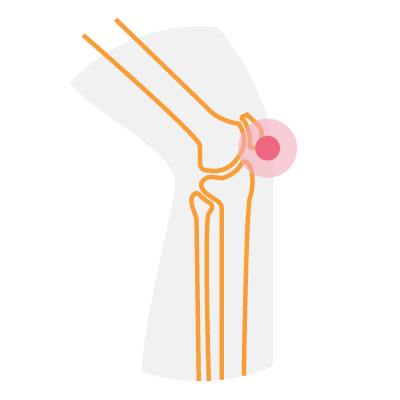
Bone and joint infection
Bone and joint infections (BJI) occur when bacteria infect the bones or joints. The most common bacteria causing these infections is Staphylococcus aureus. BJIs can happen in various ways, such as through a wound, fracture, surgery, or the bloodstream. BJIs can occur in various parts of the body, but they are most frequently found in:
- Long bones: Such as the femur (thigh bone) and tibia (shin bone).
- Joints: Especially the knee, hip, shoulder, and elbow.
- Spine: Infections can also occur in the vertebrae.
- Feet: Particularly in diabetic patients, where foot ulcers can lead to bone infections, which are a major reason for lower-limb amputations.
Infections in artificial joints (PJI: prosthetic joint infections) are serious complications after joint replacement surgeries. These infections occur in about 0.3% to 1.9% of all joint replacements.
Symptoms of BJI can include pain, swelling, redness, and warmth in the affected area. BJIs can be serious and require prompt medical attention to prevent complications. Treatment usually involves antibiotics and often surgery to remove infected tissue or foreign materials.
Clinical trials
A ‘clinical trial’ is a research study in which a potential new treatment is investigated to prevent, cure or improve a disease or medical condition. A clinical trial also looks at how participants react to the potential new treatment and if any unwanted effects occur. This helps to determine if the new investigational treatment works, is safe, and is better than those that are already available. Many clinical trials also compare existing treatments or test new ways to use or combine with existing treatments.
All new drugs must be tested in clinical trials before they can be prescribed to patients. Without people taking part in these research studies, we would have no new drugs to help others with their condition.
Clinical trial of Debio1450 in patients with bone and joint infections
Debio1450-BJI-205 is a Phase 2, open-label Definition ‘Open-label’ is a type of medical study where both the doctors and the participants know which treatment is being given. , randomized Definition ‘Randomized’ means that participants are assigned to different groups by chance, like flipping a coin. , active controlled Definition ‘Active controlled’ refers to a type of clinical trial where the new treatment being tested is compared to an existing treatment. clinical trial carried out to test the safety, tolerability, and efficacy of a new drug, afabicin (also known as Debio1450), in patients with BJI infections. The trial also compares afabicin to the usual antibiotics currently used to treat such infections.
Afabicin is a new type of antibiotic being developed to fight serious infections in bones and joints caused by harmful bacteria called staphylococci, including hard-to-treat bacteria which do not respond to many common antibiotics.
Trial participants first received either afabicin or a standard treatment (based on local medical practice and guidelines) through a drip into a vein (IV) twice a day, for up to two weeks. After that, they switched to taking their medication as a pill – afabicin twice a day or a standard treatment (based on local medical practice and guidelines), for the rest of the treatment period. The trial was divided into Part A and Part B. Different dosing regimens were evaluated in each part.
Participants could take part if:
- They were willing to adhere to study plans and procedures.
- They had been diagnosed with bone and joint infection as defined in the study protocol.
-
Phases
When a potential new medication is being developed, it is first tested in a laboratory setting. If the results are positive, the drug may enter a clinical trial program. This means that it will be tested in humans in several ‘phases’ of study.
Phase I = Safety evaluation. The very first administration in humans, typically carried out in a small group of healthy volunteers to assess if the drug is safe.
Phase II = Efficacy evaluation. The first trials in patients with the intended disease to check if the drug works efficiently and if there are any unwanted side effects.
Phase III = Confirming findings. Trials in large numbers of patients that generally compare the drug to the best treatments available._Phases
- P
- Ⅰ
- Ⅱ
- Ⅲ
- M
Talk with your medical doctor
If you are interested in participating in an upcoming clinical trial (can be also referred to as a clinical study), ask your doctor if a clinical trial might be right for you. Your doctor knows both you and your health history, which is invaluable in making this decision. Your doctor can help you gather the information needed to locate a trial and help you identify what questions might be important to ask the clinical trial doctor before deciding to participate.
Find the trials on the map
This map relies on Google Maps, which could install cookies.
Please accept them in order to show the map.
Please share any related associations that may be useful